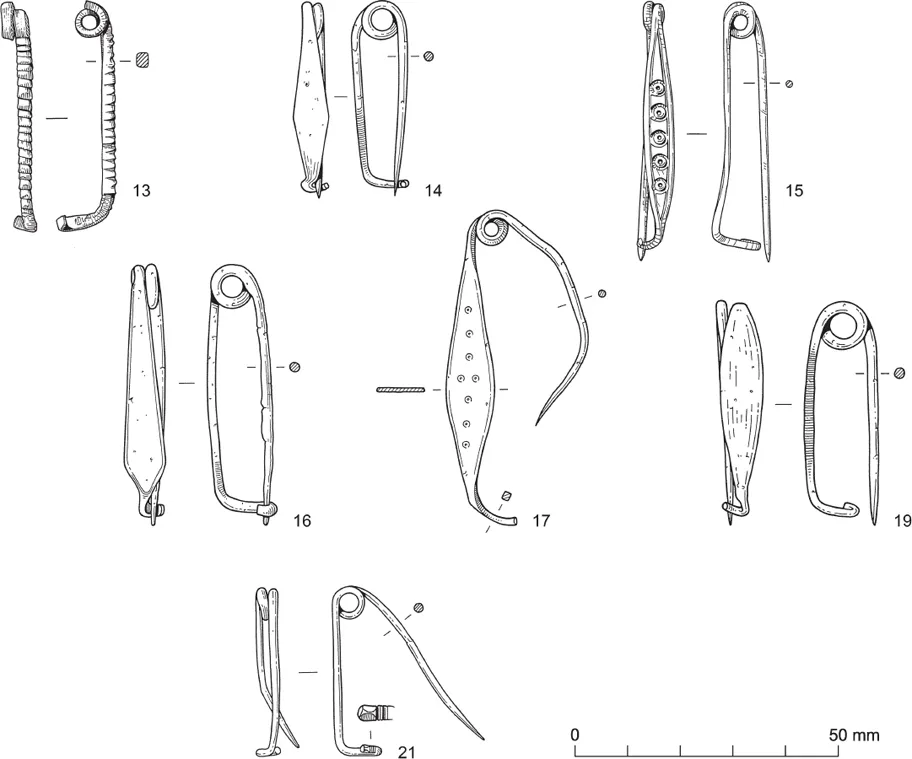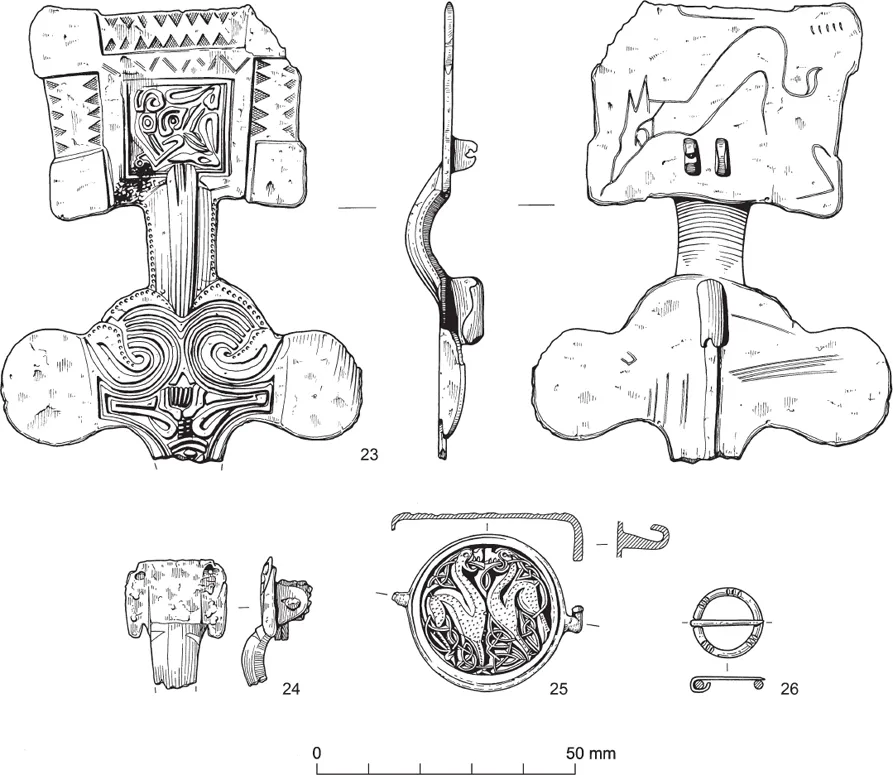![]()
1 Dress and Personal Items
Nicola Rogers, Patrick Ottaway, Gabor Thomas, Martin Foreman, Ian Panter, Susan M. Youngs, John Hines and Jennifer Jones
with contributions by Glynis Edwards†, Christopher Loveluck, Sonia O’Connor, T. P. O’Connor, Lisa M. Wastling and Jacqui Watson
The material discussed in this chapter comprises a very extensive range of brooches, strap-ends, hooked tags, buckles and belt fittings, jewellery, toilet implements, medical items, pins and combs. The bulk of the metal objects were made of copper alloy or iron; but, a few of the items are made of silver. In addition, glass, lead alloys, enamels, and various inlays and coatings have also been used in composite items. None of these items was made solely of gold, but gilding is present on a number of objects. The various finishing techniques used on many of the non-ferrous objects are discussed in detail in this chapter. Two reworked hooked tags hint at on-site production, which may also complement the other evidence for non-ferrous metalworking at this site (see Chapter 11, below).
Dress accessories and personal items in bone and antler were represented by a substantial collection of combs, and forty-one of the pins. Whilst the soil conditions were not very favourable towards the preservation of many organic materials, one wooden bead did survive. [For solitary examples of a glass bead, see Chapter 2, and a possible bone bead, Chapter 5.7.]
The importance of such dress and personal items in the life of the inhabitants of the Middle and Later Anglo-Saxon settlement is reflected in the fact that the catalogue entries presented here represent just over 8.7% of the entire Recorded Finds assemblage recovered from the site. [For the comparable material for other periods in the life of this site, the reader is referred to Chapter 14.]
***
1.1 Brooches
by Nicola Rogers, John Hines, Patrick Ottaway, Jennifer Jones and Ian Panter
Non-ferrous metal brooches
by Nicola Rogers, with a contribution by
John Hines, Jennifer Jones and Chris Loveluck
Safety-pin brooches (FIG. 1.1)
Eight copper alloy brooches (cat. nos 13–20) and one silver (no. 21: RF 10994) are of a form now termed ‘safety-pin’, alluding to their similarity to modern day safety-pins; a ninth copper alloy brooch (no. 22: RF 11935) is possibly of this type. This is a relatively rare brooch form, only recently established as a Saxon type (White 1988, 40); the ten found at Flixborough represent the largest group recovered from any Saxon site. Made in one piece, the head of the brooch is coiled once to form the sprung pin which is held securely at the other end by a looped-up catch. The design of these brooches allows little scope for varying the shape of the flat bow, which tends to be lozenge-shaped (see no. 14: RF 1968), or an elongated oval (see no. 15; RF 11043). Decoration on the bow is limited to ring-and-dot motifs (see nos 15 and 17: RFs 11043 and 12750), simple incised lines (see no. 16; RF 11595), or notches (see no. 20; RF 14425); the silver pin (no. 21; RF 10994) is plain, apart from the animal-head shaped tip of the catch loop. All the brooches appear lightweight, and White suggests that as four brooches have been found in female burials in the area of the hip, this type may have acted as a fastening for undergarments or girdles (op. cit., 41).
FIG. 1.1. Copper alloy and silver safety-pin brooches. Scale 1:1.
This brooch form appears to be based on a prehistoric type, described by Hattatt as the ‘violin bow brooch’ which he considers Bronze Age in origin (Hattatt 1989, 4), and in which classification he included examples now more likely to be interpreted as Saxon (op. cit., fig. 1, nos 1385–6). Hull and Hawkes considered other examples to be Iron Age, including two found at Whitby which Peers and Radford had suggested were Saxon copies of Bronze Age examples (1943, 58, fig. 12, nos 4, 12); Hull and Hawkes interpreted the Whitby brooches as repaired or altered Iron Age brooches (1987, 141–2, pl. 41, nos 7264–5). White identified three brooches as ‘Anglo-Saxon bow brooches’, which he noted were a previously unrecognised late 6th–7th century group, and included an example from Uncleby, East Yorks. (White 1988, 40–1, fig. 22, no. 3). None of the Flixborough brooches closely resembles those published by White, but other brooches which are similar have been found in Saxon contexts, including one found on or just above the floor of a Grubenhaus at Mucking (Hamerow 1993, 61, fig. 105, no. 2), and another found in a Middle–Late Saxon assemblage at Sedgeford, Norfolk (Cooke et al. 1997, 35). In the light of these examples, it seems likely that the Whitby brooches are also in fact Saxon, and should post-date the establishment of that site in 657AD – though as they were unstratified, they could date to any part of the occupation of the Saxon monastery between the mid 7th and the 10th centuries. Chris Loveluck comments that whilst much of the literature on these brooches places the early types in the 7th century, the vast majority of the examples now known are thought to date to the 8th and 9th centuries. The stratified examples from Flixborough (nos 13–16 and 21; RFs 3181, 1968, 11595, 11043 and 10994) all come from late 8th/early 9th century to late 9th/early 10th-century deposits, and thus appear to confirm this 8th–9th century date range. It is interesting to note that the animal-head shaped tip to the catch on no. 21 (RF 10994) is repeated on at least two other objects from the site – on the pin of buckle no. 115 (RF 3036), and the catch of the disc brooch (no. 25; RF 5467).
FIG. 1.2. Great square-headed brooch, small-long brooch, disc brooch and annular brooch. Scale 1:1.
Great square-headed brooch
(no. 23: RF 6. FIG. 1.2; PL. 1.1)
by John Hines incorporating a note on the graffito by
Chris Loveluck, and on the EDXRF analysis by
Jennifer Jones
The great square-headed brooch from Flixborough belongs to group XVII of the Anglo-Saxon great square-headed brooch series according to the current classification (Hines 1997, esp. 133–41). This group is made up of brooches of a relatively uniform type, of which 18 examples are now known. The majority of these have been found in East Anglia, but more northerly outliers, such as this example, have been found at Market Overton, Rutland (Leics.), Ruskington (Lincs.), Londesborough (E. Yorks.) and Thornborough Pasture, near Catterick (N. Yorks.). The group is placed in Phase 3 of the square-headed brooch series, a phase for which a date-range of manufacture between c.530 and 570 is proposed.
The Flixborough brooch is an interesting example in several respects. The backward-facing animal in the headplate inner panel is clearer, more detailed, and more coherent than a related design found on several other brooches in this group. It ...


